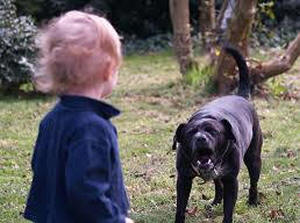About Canine Agression
 Canine aggression syndromes must be carefully be evaluated. Even though many of these types of disorders look the same and even may be very similar for dogs as a whole, we must evaluate the complexity of the behavioral, emotional or genetic responses to every day stimuli in order to develop a systematic step-by-step approach to help problem solve the issues. This also includes identifying common triggers points, such as social interaction, positional control, physical contact and sound associations. Through one-on-one In-Home training lesson a behavior modification plan begins with a complete evaluation of the dog’s home environment, daily actives and any active participating family member role plays. Dog behavior training and canine modification and problem solving can take a long time (depending on varying circumstances) which requires dog owner’s daily participation as well as plenty of practice, patience and persistence.
Canine aggression syndromes must be carefully be evaluated. Even though many of these types of disorders look the same and even may be very similar for dogs as a whole, we must evaluate the complexity of the behavioral, emotional or genetic responses to every day stimuli in order to develop a systematic step-by-step approach to help problem solve the issues. This also includes identifying common triggers points, such as social interaction, positional control, physical contact and sound associations. Through one-on-one In-Home training lesson a behavior modification plan begins with a complete evaluation of the dog’s home environment, daily actives and any active participating family member role plays. Dog behavior training and canine modification and problem solving can take a long time (depending on varying circumstances) which requires dog owner’s daily participation as well as plenty of practice, patience and persistence.
When a profession behavior trainer comes into your home to evaluate and asses your concerns with your dog’s behaviors, there is much more than meets the eye. Not only do they need to learn as much as they can about the dogs back ground, daily routines and the past history, they also need to understand the family dynamic around their environment and others that may be directly involved with their training. The more experience a trainer has the better equipped they will be diagnosing the problems. Once the correct methods are used and education is given, a dog owner will lead with control and confidence. No matter what breed, age, or issue, with a dog, a proper proven and effective approach will generally save a dog’s life.
Why In-Home Service vs. Group Training Classes
Your dog lives in your home 95% or more of the time. This is where they develop both good and poor behaviors and where training will be most effective. Dogs learn by association, not by time, feelings or our emotional response to them. This is why I believe gaining better knowledge and more realistic perspective will help your dog towards a healthier and happier life. Think about it, if your dog won’t listen to you at home, they will not listen to you anywhere.
How to Establish Yourself as the Family Leader
Once the role of family leader/leaders is established by you, other problems and concerns will drop into place. With all the training tips you see on the web that have good intentions will not matter if your dog doesn’t view you as leader and have a healthy respect for you, your family and even your other dogs. Canines have an instinctive need and desire for the social groups to positioning themselves, in order to control their environment. Dog owners must learn to self- confidently do their best to take that role away in order to lead their environment in such a way not to hurt or break a dogs spirit.
Dog behavior issues almost always come from lack of a consistent leadership role play as well as inconsistent messages. Leadership in the home isn’t difficult to achieve, with simple daily training exercises, it simply requires a basic understanding of canine behavior as it relates to a dogs Once you’ve assumed the role as leader, all you will need is consistency and clarity which will be taught to you by Mr. Bob of Bobs Pet Stop. This will reinforce and support the tie between you and your pet.
Developed by Bob with over 30 years of “Hands-on” experience, and working with thousands of different people and their pets, Bob focus on developing a healthy and wholesome relationship between owner and dog to ensure a successful future. Bob’s dog behavior and obedience techniques exhibit the same basic communication techniques as dogs exhibit among themselves using, audio signals, behavior signals and contact signals to help mimic what dogs have been doing for thousands of years among themselves.
Are all Dogs Basically the Same?
Yes, in the sense that they are pack animals and they understand foundation canine learning, but with that said, I believe they are not the same as individuals much like us as human beings, so we as dog owner/trainer need to change our training understanding based upon each dog’s personality trait and temperament and what will work for that dog. We also must change the dog behavior training techniques to meet the real needs of each individual dog owner.
